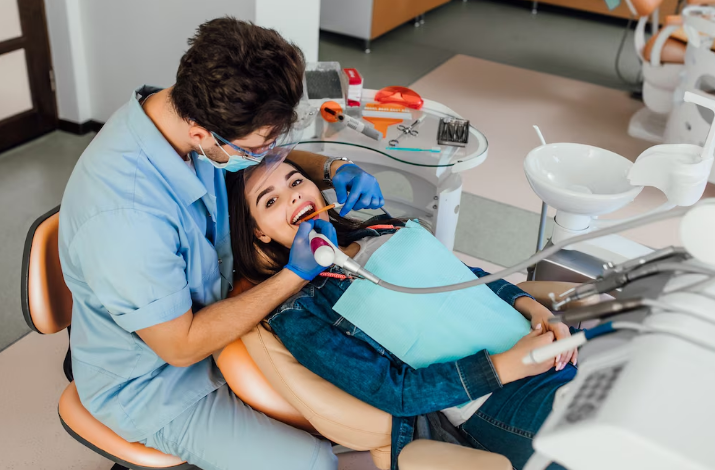How Dentists in San Diego Are Using Botox to Treat TMJ Disorders

In San Diego, dentists are finding innovative ways to help patients suffering from TMJ disorders. One such method gaining popularity is the use of Botox. Originally known for its cosmetic applications, Botox is now being utilized to alleviate jaw pain and tension associated with TMJ. This article explores how dentists in San Diego CA are incorporating this treatment into their practices, providing relief to many who struggle with TMJ symptoms.
Key Takeaways
- Botox helps relax jaw muscles, reducing TMJ pain.
- The treatment is quick and usually done in a dentist’s office.
- Results can vary; some patients feel relief within days.
- Not everyone is a candidate for Botox; a consultation is needed.
- Alternative treatments for TMJ exist, including physical therapy and medication.
Understanding TMJ Disorders
What Is TMJ?
TMJ stands for temporomandibular joint, which is basically the hinge connecting your jaw to your skull. You’ve got one on each side of your face. When people talk about “TMJ,” they’re usually referring to TMD, or temporomandibular joint disorder. It’s what happens when that joint gets all messed up – inflamed, damaged, or just not working right.
Common Symptoms of TMJ
So, how do you know if you’ve got TMJ issues? Well, there are a bunch of signs to look out for. It’s not just jaw pain, though that’s a big one. You might also experience:
- Clicking or popping sounds when you move your jaw.
- Trouble chewing or a bite that feels off.
- Lockjaw – when your jaw gets stuck open or closed.
- Headaches, sometimes even neck and shoulder pain.
It’s easy to brush off some of these symptoms as just a headache or muscle tension, but if they’re happening often and you’re also having jaw issues, it’s worth checking out.
Causes of TMJ Disorders
What causes this whole mess in the first place? Lots of things, actually. Sometimes it’s from:
- Injuries to the jaw, like a hit or whiplash.
- Grinding your teeth (bruxism), especially at night.
- Arthritis in the joint.
- Stress, which can make you clench your jaw.
It can be tricky to pinpoint the exact cause, and sometimes it’s a combination of factors. That’s why getting a proper diagnosis is important.
The Role of Botox in TMJ Treatment
How Botox Works for TMJ
Botox, or botulinum toxin, is a neurotoxic protein that can be used to treat TMJ disorders. It works by blocking nerve signals to the muscles responsible for jaw movement, causing them to relax. This relaxation can reduce the pain and discomfort associated with TMJ. The injections are typically administered directly into the masseter and temporalis muscles, which are major players in chewing and jaw clenching. The effect isn’t permanent, usually lasting for several months, after which the injections may need to be repeated. It’s a pretty straightforward process, and many patients find it a helpful way to manage their symptoms, especially when other treatments haven’t provided enough relief.
Benefits of Botox for Jaw Pain
Botox injections can offer several benefits for people dealing with jaw pain from TMJ. Here are a few:
- Pain Reduction: By relaxing the jaw muscles, botox can significantly reduce pain and discomfort.
- Reduced Muscle Tension: Botox helps ease muscle tension, which is a common cause of headaches and jaw pain.
- Improved Jaw Function: For some, botox can improve jaw movement and reduce clicking or popping sounds.
Botox for TMJ in San Diego is becoming a more common treatment option. It’s important to remember that while botox can provide relief, it’s not a cure. It’s often used in combination with other therapies to manage TMJ symptoms effectively.
Limitations of Botox Treatment
While botox for tmj san diego can be a helpful treatment, it’s important to be aware of its limitations. It’s not a permanent fix, and the effects wear off over time, usually within a few months. Repeated injections may lead to the development of antibodies, potentially reducing the effectiveness of future treatments. There’s also the risk of side effects, although they are generally mild and temporary. It’s also worth noting that botox may not be effective for all types of TMJ disorders, and it’s not a substitute for addressing underlying issues like teeth grinding or jaw misalignment. It’s best to discuss these limitations with your dentist to determine if botox is the right choice for you.
Choosing a Dentist in San Diego CA for Botox
Finding the right professional for Botox treatment, especially for TMJ disorders, is important. You want someone who knows what they’re doing and can provide safe, effective care. Here’s what to look for when choosing a dentist in San Diego CA for Botox.
Finding Qualified Providers
Not all dentists are trained or experienced in administering Botox for TMJ. Here’s how to find a qualified provider:
- Check Credentials: Look for dentists who have specific training in Botox administration, especially for TMJ disorders. Certifications and continuing education courses are good signs.
- Read Reviews and Testimonials: See what other patients say about their experiences. Online reviews can provide insights into the dentist’s skills and patient care.
- Ask About Experience: Find out how long the dentist has been using Botox for TMJ and how many patients they’ve treated. More experience usually means better results.
What to Expect During Your Visit
Knowing what to expect can ease any anxiety about the procedure:
- Initial Consultation: The dentist should conduct a thorough exam and discuss your TMJ symptoms, medical history, and treatment goals.
- Treatment Plan: A personalized plan should be created, outlining the number of units of Botox needed and the injection sites.
- The Procedure: The injections are usually quick, but the dentist should explain each step and address any concerns you have.
Questions to Ask Your Dentist
Asking the right questions can help you make an informed decision:
- What are your qualifications and experience with Botox for TMJ?
- How many units of Botox do you recommend for my specific case?
- What are the potential risks and side effects of the treatment?
- How long will the effects of Botox last, and how often will I need treatments?
- What is the total cost of the treatment, and what payment options are available?
Choosing the right dentist San Diego CA for Botox involves doing your homework. Don’t hesitate to ask questions and ensure you feel comfortable with the provider and their approach to treating your TMJ disorder. Your health and well-being are the top priorities.
Alternative Treatments for TMJ Disorders
Botox isn’t the only game in town when it comes to tackling TMJ disorders. It’s good to know what else is out there, especially since everyone responds differently to treatment. Let’s explore some other options.
Physical Therapy Options
Physical therapy can be a really effective way to manage TMJ pain and improve jaw function. A physical therapist can teach you exercises to strengthen your jaw muscles, improve your range of motion, and reduce pain. They might also use techniques like massage, heat, or cold therapy to ease discomfort. It’s all about getting your jaw moving smoothly and pain-free.
Medications and Pain Relief
When pain flares up, medications can offer some relief. Over-the-counter pain relievers like ibuprofen or naproxen can help with inflammation and pain. For more severe pain, your doctor might prescribe stronger pain medications or muscle relaxants. It’s important to use these medications as directed and talk to your doctor about any potential side effects.
Surgical Interventions
Surgery is usually considered a last resort for TMJ disorders, but it can be an option if other treatments haven’t worked. There are several types of surgical procedures, ranging from minimally invasive arthroscopy to open-joint surgery. The goal of surgery is to repair or replace the damaged joint, reduce pain, and improve jaw function. Recovery from surgery can take time, so it’s important to weigh the risks and benefits carefully with your doctor.
It’s worth remembering that TMJ treatment often involves a combination of approaches. What works for one person might not work for another, so it’s important to work closely with your dentist or doctor to find the best treatment plan for you. Don’t be afraid to explore different options and find what brings you the most relief.
Patient Experiences with Botox for TMJ
Success Stories
It’s always good to hear how things go for other people, right? Well, when it comes to Botox for TMJ, a lot of folks in San Diego have had some pretty good experiences. Many report a significant reduction in jaw pain and tension, which can be life-changing if you’ve been dealing with chronic discomfort. It’s not a cure-all, but for some, it’s been a real game changer.
Potential Side Effects
Okay, so it’s not all sunshine and rainbows. Like any treatment, Botox has potential side effects. Most are pretty mild, like some temporary muscle weakness around the injection site, or maybe a bit of bruising. Some people get a headache or flu-like symptoms for a day or two after. Drooping eyelids are also a possibility, but it’s not super common. It’s important to remember that these side effects are usually temporary, but it’s still good to know what you might be in for.
Long-Term Results
So, what happens down the road? Botox isn’t a permanent fix, so the effects wear off over time. Usually, you’re looking at about 3-6 months of relief. After that, you might need another treatment. Some people worry about building up a resistance to Botox if they use it repeatedly. To avoid this, doctors usually recommend using the lowest effective dose and spacing out treatments as much as possible. It’s all about finding the right balance to manage your symptoms without overdoing it.
It’s important to have realistic expectations. Botox can be a great tool for managing TMJ symptoms, but it’s not a magic bullet. It works best when combined with other therapies, like physical therapy or stress management techniques. Talk to your dentist about a comprehensive treatment plan that addresses all aspects of your TMJ disorder.
Cost and Insurance Considerations
Understanding Treatment Costs
Okay, so you’re thinking about Botox for your TMJ in San Diego. Let’s talk money. The cost can change a lot depending on a few things. How many units of Botox you need, the dentist’s fees, and how many visits you’ll need all play a part. Generally, you might be looking at a few hundred dollars per treatment session. It’s a good idea to get a quote from a few different dentists to see what the going rate is in your area. Don’t be afraid to ask for a breakdown of the costs so you know exactly what you’re paying for.
Insurance Coverage for Botox
Now, here’s the tricky part: insurance. Most dental insurance plans don’t cover Botox for TMJ because they consider it a cosmetic procedure, even though it’s being used for a medical reason. Medical insurance might cover it, but it’s rare and usually requires a lot of paperwork and proof that other treatments haven’t worked. Call your insurance company and ask specifically about Botox for TMJ. Get everything in writing, if possible, so you have it for your records. Don’t assume anything; insurance companies can be surprising.
Financing Options for Patients
So, what if insurance doesn’t cover it? Don’t give up just yet. Many dental offices in San Diego offer financing options or payment plans to help spread out the cost of treatment. You could also look into using a healthcare credit card, like CareCredit, which is designed for medical and dental expenses. These cards often have promotional periods with low or no interest, which can make the treatment more affordable. Just make sure you understand the terms and conditions before you sign up. Another option is to check if your dentist offers any in-house payment plans. Some are willing to work with you directly to create a payment schedule that fits your budget.
It’s important to remember that while cost is a factor, you shouldn’t choose a dentist based on price alone. Experience and qualifications are way more important when it comes to something like Botox injections. You want someone who knows what they’re doing to avoid any complications.
Here’s a quick rundown of potential financing options:
- Healthcare credit cards (e.g., CareCredit)
- Dental office payment plans
- Personal loans
- Health savings accounts (HSAs) or flexible spending accounts (FSAs), if eligible
Future of Botox in Dental Practices
Emerging Research
The use of Botox in dentistry is still a relatively new field, and ongoing research continues to explore its potential applications. Current studies are investigating the effectiveness of Botox for treating conditions beyond TMJ disorders, such as bruxism, gummy smiles, and even certain types of headaches. Researchers are also working to refine injection techniques and dosages to optimize results and minimize side effects. This includes exploring the use of advanced imaging technologies to guide injections with greater precision.
Expanding Applications
As our understanding of Botox deepens, its applications in dental practices are likely to expand. Here are some potential areas:
- Orthodontics: Assisting in muscle retraining after orthodontic treatment.
- Implant Dentistry: Managing muscle spasms that can affect implant integration.
- Cosmetic Enhancements: Providing more comprehensive facial aesthetic treatments.
The future of Botox in dentistry looks promising, with the potential to offer patients a wider range of therapeutic and cosmetic benefits. As research progresses and techniques are refined, we can expect to see even more innovative uses for Botox in dental practices.
Patient Education and Awareness
One of the biggest hurdles to wider adoption of Botox in dentistry is a lack of patient awareness. Many people still primarily associate Botox with cosmetic procedures and are unaware of its therapeutic potential for conditions like TMJ disorders. Dentists have a crucial role to play in educating their patients about the benefits of Botox and addressing any misconceptions or concerns they may have. This includes:
- Providing clear and accurate information about Botox treatment.
- Discussing the potential risks and benefits in detail.
- Sharing patient testimonials and success stories.
By increasing patient education and awareness, dentists can help more people access this effective treatment option and improve their quality of life.
Final Thoughts on Botox for TMJ Relief
In summary, Botox is becoming a go-to option for many dentists in San Diego when it comes to treating TMJ disorders. It’s not just about looking good anymore; it’s about feeling better too. For those dealing with jaw pain, headaches, or muscle tension, Botox can provide some much-needed relief. While it’s not a one-size-fits-all solution, it’s worth considering if other treatments haven’t worked. If you think Botox might help you, don’t hesitate to reach out to a local dentist for a consultation. They can help you figure out if it’s the right choice for your situation.
Frequently Asked Questions
What is TMJ?
TMJ stands for temporomandibular joint, which connects your jaw to your skull. It’s important for actions like chewing and talking.
How can Botox help with TMJ disorders?
Botox can help by relaxing the muscles around your jaw. This can reduce pain and discomfort caused by tension or grinding your teeth.
Are there any side effects of Botox for TMJ?
Some people might experience swelling, bruising, or mild pain at the injection site. These effects usually go away quickly.
How long does Botox treatment last for TMJ?
The effects of Botox can last for several months, but you may need repeat treatments to maintain relief.
Is Botox for TMJ covered by insurance?
Insurance coverage for Botox varies. It’s best to check with your insurance provider to see if they cover it for TMJ treatment.
What other treatments are available for TMJ?
Other treatment options include physical therapy, medications, and sometimes surgery, depending on the severity of the condition.





